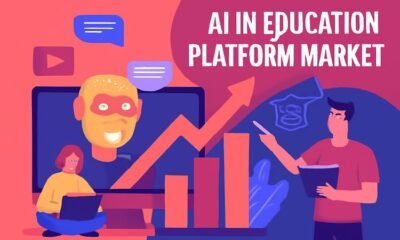AI Insights
Artificial Intelligence (AI) in Medical Coding Market Rising

In 2023, the global Artificial Intelligence (AI) in medical coding market was valued at approximately USD 1.15 billion, and it is projected to reach around USD 7.25 billion by 2033, growing at a compound annual growth rate (CAGR) of about 20.0% from 2024 to 2033.
Artificial Intelligence (AI) in Medical Coding Market Overview
The AI in medical coding market is rapidly growing as healthcare providers seek automation to improve accuracy, speed, and compliance in the billing and reimbursement process. AI-powered solutions are being widely adopted to reduce administrative burdens, eliminate human errors, and ensure accurate diagnosis and procedure coding. The integration of natural language processing (NLP), machine learning, and predictive analytics enables real-time data extraction from electronic health records (EHRs). Increasing healthcare digitization, a global push for cost containment, and labor shortages in the medical coding workforce are driving market demand. North America leads adoption due to advanced healthcare infrastructure and regulatory pressure, while Asia-Pacific is emerging due to growing investments in health IT. Despite concerns around data privacy and algorithm transparency, the market is poised for strong long-term growth.
Request a sample copy of this report at: https://www.omrglobal.com/request-sample/ai-in-medical-coding-market
Advantages of requesting a Sample Copy of the Report:
1) To understand how our report can bring a difference to your business strategy
2) To understand the analysis and growth rate in your region
3) Graphical introduction of global as well as the regional analysis
4) Know the top key players in the market with their revenue analysis
5) SWOT analysis, PEST analysis, and Porter’s five force analysis
The report further explores the key business players along with their in-depth profiling
3M, Optum, Cerner, IBM Watson Health, Truven Health Analytics, McKesson, Change Healthcare
Artificial Intelligence (AI) in Medical Coding Market Segments:
◘ By Type: Machine Learning, Natural Language Processing, Deep Learning
◘ By Application: Medical Billing, Healthcare IT, Healthcare Management
Report Drivers & Trends Analysis:
The report also discusses the factors driving and restraining market growth, as well as their specific impact on demand over the forecast period. Also highlighted in this report are growth factors, developments, trends, challenges, limitations, and growth opportunities. This section highlights emerging Artificial Intelligence (AI) in Medical Coding Market trends and changing dynamics. Furthermore, the study provides a forward-looking perspective on various factors that are expected to boost the market’s overall growth.
Competitive Landscape Analysis:
In any market research analysis, the main field is competition. This section of the report provides a competitive scenario and portfolio of the Artificial Intelligence (AI) in Medical CodingMarket’s key players. Major and emerging market players are closely examined in terms of market share, gross margin, product portfolio, production, revenue, sales growth, and other significant factors. Furthermore, this information will assist players in studying critical strategies employed by market leaders in order to plan counterstrategies to gain a competitive advantage in the market.
Regional Outlook:
The following section of the report offers valuable insights into different regions and the key players operating within each of them. To assess the growth of a specific region or country, economic, social, environmental, technological, and political factors have been carefully considered. The section also provides readers with revenue and sales data for each region and country, gathered through comprehensive research. This information is intended to assist readers in determining the potential value of an investment in a particular region.
» North America (U.S., Canada, Mexico)
» Europe (Germany, U.K., France, Italy, Russia, Spain, Rest of Europe)
» Asia-Pacific (China, India, Japan, Singapore, Australia, New Zealand, Rest of APAC)
» South America (Brazil, Argentina, Rest of SA)
» Middle East & Africa (Turkey, Saudi Arabia, Iran, UAE, Africa, Rest of MEA)
If you have any special requirements, Request customization: https://www.omrglobal.com/report-customization/ai-in-medical-coding-market
Key Benefits for Stakeholders:
⏩ The study represents a quantitative analysis of the present Artificial Intelligence (AI) in Medical Coding Market trends, estimations, and dynamics of the market size from 2025 to 2032 to determine the most promising opportunities.
⏩ Porter’s five forces study emphasizes the importance of buyers and suppliers in assisting stakeholders to make profitable business decisions and expand their supplier-buyer network.
⏩ In-depth analysis, as well as the market size and segmentation, help you identify current Artificial Intelligence (AI) in Medical Coding Market opportunities.
⏩ The largest countries in each region are mapped according to their revenue contribution to the market.
⏩ The Artificial Intelligence (AI) in Medical Coding Market research report gives a thorough analysis of the current status of the Artificial Intelligence (AI) in Medical Coding Market’s major players.
Key questions answered in the report:
➧What will the market development pace of the Artificial Intelligence (AI) in Medical Coding Market?
➧What are the key factors driving the Artificial Intelligence (AI) in Medical Coding Market?
➧Who are the key manufacturers in the market space?
➧ What are the market openings, market hazards,s and market outline of the Artificial Intelligence (AI) in Medical Coding Market?
➧What are the sales, revenue, and price analysis of the top manufacturers of the Artificial Intelligence (AI) in Medical Coding Market?
➧Who are the distributors, traders, and dealers of Artificial Intelligence (AI) in Medical Coding Market?
➧What are the market opportunities and threats faced by the vendors in the Artificial Intelligence (AI) in Medical Coding Market?
➧What are deals, income, and value examination by types and utilizations of the Artificial Intelligence (AI) in Medical Coding Market?
➧What are deals, income, and value examination by areas of enterprises in the Artificial Intelligence (AI) in Medical Coding Market?
Purchase Now Up to 25% Discount on This Premium Report: https://www.omrglobal.com/buy-now/ai-in-medical-coding-market
Reasons To Buy The Artificial Intelligence (AI) in Medical Coding Market Report:
➼ In-depth analysis of the market on the global and regional levels.
➼ Major changes in market dynamics and competitive landscape.
➼ Segmentation on the basis of type, application, geography, and others.
➼ Historical and future market research in terms of size, share growth, volume, and sales.
➼ Major changes and assessment in market dynamics and developments.
➼ Emerging key segments and regions
➼ Key business strategies by major market players and their key methods
Contact Us:
Mr. Anurag Tiwari
Email: anurag@omrglobal.com
Contact no: +91 780-304-0404
Website: www.omrglobal.com
Follow Us: LinkedIn | Twitter
About Orion Market Research
Orion Market Research (OMR) is a market research and consulting company known for its crisp and concise reports. The company is equipped with an experienced team of analysts and consultants. OMR offers quality syndicated research reports, customized research reports, consulting and other research-based services. The company also offers Digital Marketing services through its subsidiary OMR Digital and Software development and Consulting Services through another subsidiary Encanto Technologies.
This release was published on openPR.
AI Insights
Generative vs. agentic AI: Which one really moves the customer experience needle?
Artificial intelligence, first coined by John McCarthy in 1956, lay dormant for decades before exploding into a cultural and business phenomenon post-2012. From predictive algorithms to chatbots and creative tools, AI has evolved rapidly. Now, two powerful paradigms are shaping its future: generative AI, which crafts content from text to art, and agentic AI, which acts autonomously to solve complex tasks. But should businesses pit generative AI against agentic AI or combine them to innovate? The answer isn’t binary, because these technologies aren’t competing forces. In fact, they often complement each other in powerful ways, especially when it comes to transforming customer engagement.
The rise of generative AI: Creativity meets scale
Generative AI is all about creation; it represents the imaginative side of artificial intelligence. From producing marketing copy and designing campaign visuals to generating product descriptions and chat responses, generative AI has unlocked new possibilities for enterprises looking to scale content and personalisation like never before.
Fuelled by powerful models like ChatGPT, DALL·E, and MidJourney, these systems have entered the enterprise stack at speed. Marketing teams are using them to brainstorm ideas and accelerate go-to-market efforts. Customer support teams are deploying them to enhance chatbot interactions with more human-like language. Product teams are using generative AI to auto-draft FAQs or documentation. And sales teams are experimenting with tailored email pitches generated from past deal data.
At the heart of this capability is the model’s ability to learn from massive datasets, analysing and replicating patterns in text, visuals, and code to produce new, relevant content on demand. This has made generative AI a valuable tool in customer engagement workflows where speed, relevance, and personalisation are paramount. But while generative AI can start the conversation, it rarely finishes it. That’s where its limitations show up.
For instance, it can draft a beautifully written response to a billing query, but it can’t resolve the issue by accessing the customer’s account, applying credits, or triggering workflows across enterprise systems. In other words, it creates the message but not the outcome. This creative strength makes generative AI a powerful enabler of customer engagement but not a complete solution. To drive real business value, measured in resolution rates, retention, and revenue, enterprises need to go beyond content generation and toward intelligent action. This is where agentic AI comes into play.
How agentic AI is redefining enterprise and consumer engagement
As the need for deeper automation grows, agentic AI is taking centre stage. Agentic AI is built to act; it makes decisions, takes autonomous actions, and adapts in real time to achieve goals. For businesses, this marks a transformative shift. Generative AI has empowered enterprises to accelerate communication, generate insights, and personalise engagement. Agentic AI, on the other hand, goes beyond assistance to autonomy. Imagine a virtual enterprise assistant that doesn’t just draft emails but manages entire customer service workflows — triggering follow-ups, updating CRM systems, and escalating issues when needed.
In industries like supply chain, finance, and telecom, agentic AI can dynamically reconfigure networks, detect anomalies, or reroute deliveries—all with minimal human input. It’s a new era of AI-driven execution. On the consumer front, agentic AI takes engagement from passive response to proactive assistance. Think of a digital concierge that not only understands your intent but acts on your behalf — tracking shipments or negotiating a better mobile plan based on usage patterns.
A new layer of intelligence — with responsibility
The increased autonomy of agentic AI raises important questions around trust, governance, and accountability. Who’s liable when an agentic system makes an error or an ethically questionable decision? Enterprises adopting such systems will need to ensure alignment with human values, transparency in decision-making, and robust fail-safes.
Generative and agentic AI are not rivals — they’re complementary forces that, together, enable a new era of intelligent enterprise and consumer engagement.
When generative meets agentic AI
Generative AI and agentic AI may serve different functions. However, rather than operating in isolation, these technologies frequently collaborate, enhancing both communication and execution.
Take, for example, a virtual customer service agent. The agentic AI manages the flow of interaction, makes decisions, and determines next steps, while generative AI crafts clear, personalised responses tailored to the conversation in real time.
This collaborative dynamic also plays out in robotics. Imagine a robot chef: generative AI could invent creative recipes based on user tastes and available ingredients, while agentic AI would take over the cooking, executing the recipe with precision and adapting to real-time conditions in the kitchen.
Summing Up
As AI continues to evolve, the boundaries between generative and agentic systems will become increasingly fluid. We’re heading toward a future where AI doesn’t just imagine possibilities but also brings them to life, merging creativity with execution in a seamless loop. This fusion holds immense promise across industries, from streamlining healthcare operations to revolutionising manufacturing workflows.
However, with such transformative power comes great responsibility. Ethical development, transparency, and accountability must remain non-negotiable, especially when it comes to safeguarding consumer data. As these systems take on more autonomous roles, ensuring privacy, security, and user consent will be critical to building trust.
By understanding the distinct roles and combined potential of generative and agentic AI, we can shape a future where technology enhances human capability responsibly, meaningfully, and with integrity at its core.
This article is authored by Harsha Solanki, VP GM Asia, Infobip.
Disclaimer: The views expressed in this article are those of the author/authors and do not necessarily reflect the views of ET Edge Insights, its management, or its members
AI Insights
Students combat artificial intelligence in the pines – jackcentral.org
AI Insights
How AI is eroding human memory and critical thinking
-

 Business1 week ago
Business1 week agoThe Guardian view on Trump and the Fed: independence is no substitute for accountability | Editorial
-
Tools & Platforms4 weeks ago
Building Trust in Military AI Starts with Opening the Black Box – War on the Rocks
-

 Ethics & Policy1 month ago
Ethics & Policy1 month agoSDAIA Supports Saudi Arabia’s Leadership in Shaping Global AI Ethics, Policy, and Research – وكالة الأنباء السعودية
-

 Events & Conferences4 months ago
Events & Conferences4 months agoJourney to 1000 models: Scaling Instagram’s recommendation system
-

 Jobs & Careers2 months ago
Jobs & Careers2 months agoMumbai-based Perplexity Alternative Has 60k+ Users Without Funding
-

 Education2 months ago
Education2 months agoVEX Robotics launches AI-powered classroom robotics system
-

 Podcasts & Talks2 months ago
Podcasts & Talks2 months agoHappy 4th of July! 🎆 Made with Veo 3 in Gemini
-

 Funding & Business2 months ago
Funding & Business2 months agoKayak and Expedia race to build AI travel agents that turn social posts into itineraries
-

 Education2 months ago
Education2 months agoMacron says UK and France have duty to tackle illegal migration ‘with humanity, solidarity and firmness’ – UK politics live | Politics
-

 Podcasts & Talks2 months ago
Podcasts & Talks2 months agoOpenAI 🤝 @teamganassi























